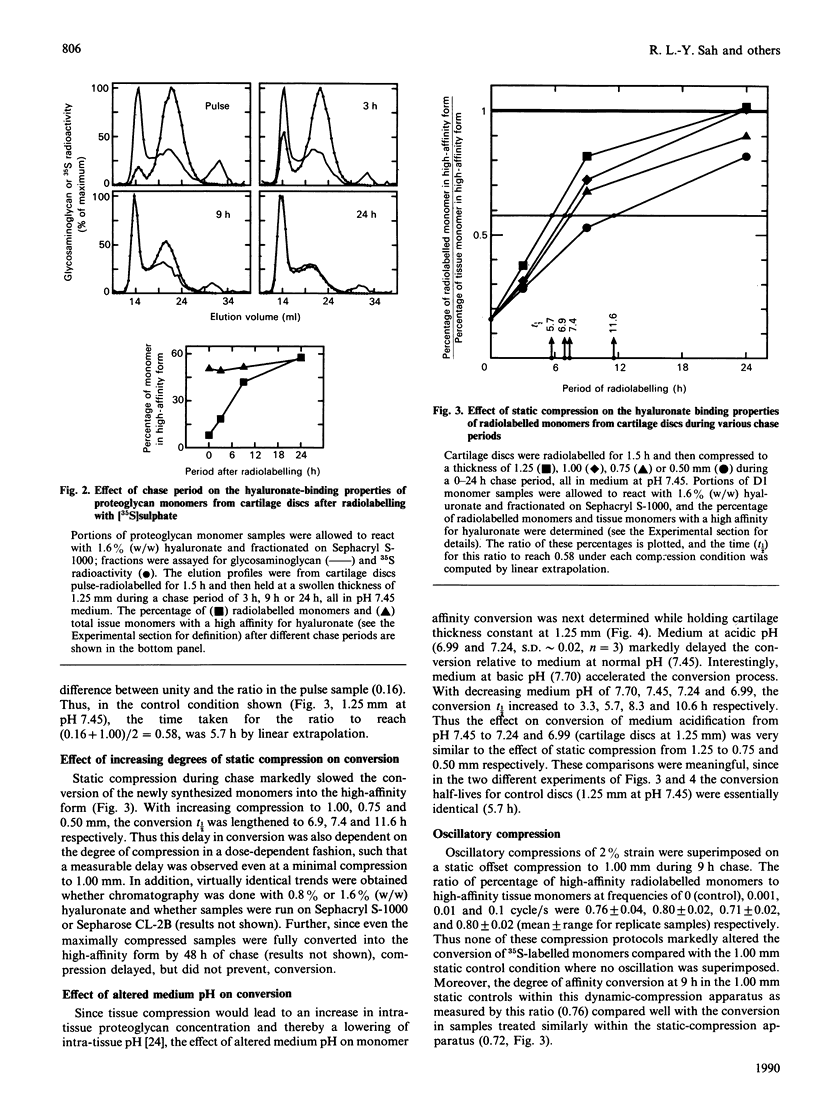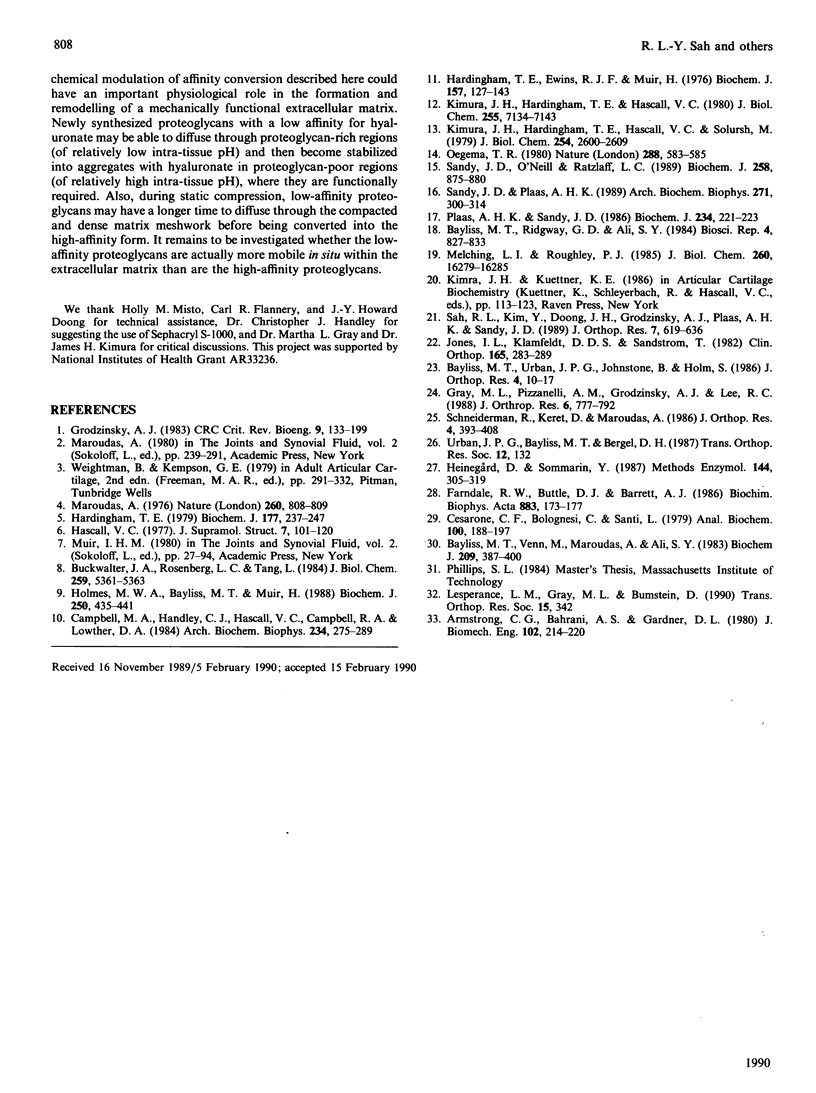Abstract
The effects of tissue compression on the hyaluronate-binding properties of newly synthesized proteoglycans in calf cartilage explants were examined. Pulse-chase experiments showed that conversion of low-affinity monomers to the high-affinity form (that is, to a form capable of forming aggregates with 1.6% hyaluronate on Sephacryl S-1000) occurred with a t1/2 of about 5.7 h in free-swelling discs at pH 7.45. Static compression during chase (in pH 7.45 medium) slowed the conversion, as did incubation in acidic medium (without compression). Both effects were dose-dependent. For example, the t1/2 for conversion was increased to about 11 h by either (1) compression from a thickness of 1.25 mm to 0.5 mm or (2) medium acidification from pH 7.45 to 6.99. Oscillatory compression of 2% amplitude at 0.001, 0.01, or 0.1 cycles/s during chase did not, however, affect the conversion. Changes in the hyaluronate-binding affinity of [35S]proteoglycans in these experiments were accompanied by no marked change in the high percentage (approximately 80%) of monomers which could form aggregates with excess hyaluronate and link protein. Since static tissue compression would result in an increased matrix proteoglycan concentration and thereby a lower intra-tissue pH [Gray, Pizzanelli, Grodzinsky & Lee (1988) J. Orthop. Res. 6, 777-792], it seems likely that matrix pH may influence proteoglycan aggregate assembly by an effect on the hyaluronate-binding affinity of proteoglycan monomer. Such a pH mechanism might have a physiological role, promoting proteoglycan deposition in regions of low proteoglycan concentration.
Full text
PDF





Selected References
These references are in PubMed. This may not be the complete list of references from this article.
- Bayliss M. T., Ridgway G. D., Ali S. Y. Delayed aggregation of proteoglycans in adult human articular cartilage. Biosci Rep. 1984 Oct;4(10):827–833. doi: 10.1007/BF01138164. [DOI] [PubMed] [Google Scholar]
- Bayliss M. T., Urban J. P., Johnstone B., Holm S. In vitro method for measuring synthesis rates in the intervertebral disc. J Orthop Res. 1986;4(1):10–17. doi: 10.1002/jor.1100040102. [DOI] [PubMed] [Google Scholar]
- Bayliss M. T., Venn M., Maroudas A., Ali S. Y. Structure of proteoglycans from different layers of human articular cartilage. Biochem J. 1983 Feb 1;209(2):387–400. doi: 10.1042/bj2090387. [DOI] [PMC free article] [PubMed] [Google Scholar]
- Buckwalter J. A., Rosenberg L. C., Tang L. H. The effect of link protein on proteoglycan aggregate structure. An electron microscopic study of the molecular architecture and dimensions of proteoglycan aggregates reassembled from the proteoglycan monomers and link proteins of bovine fetal epiphyseal cartilage. J Biol Chem. 1984 May 10;259(9):5361–5363. [PubMed] [Google Scholar]
- Campbell M. A., Handley C. J., Hascall V. C., Campbell R. A., Lowther D. A. Turnover of proteoglycans in cultures of bovine articular cartilage. Arch Biochem Biophys. 1984 Oct;234(1):275–289. doi: 10.1016/0003-9861(84)90350-3. [DOI] [PubMed] [Google Scholar]
- Cesarone C. F., Bolognesi C., Santi L. Improved microfluorometric DNA determination in biological material using 33258 Hoechst. Anal Biochem. 1979 Nov 15;100(1):188–197. doi: 10.1016/0003-2697(79)90131-3. [DOI] [PubMed] [Google Scholar]
- Farndale R. W., Buttle D. J., Barrett A. J. Improved quantitation and discrimination of sulphated glycosaminoglycans by use of dimethylmethylene blue. Biochim Biophys Acta. 1986 Sep 4;883(2):173–177. doi: 10.1016/0304-4165(86)90306-5. [DOI] [PubMed] [Google Scholar]
- Gray M. L., Pizzanelli A. M., Grodzinsky A. J., Lee R. C. Mechanical and physiochemical determinants of the chondrocyte biosynthetic response. J Orthop Res. 1988;6(6):777–792. doi: 10.1002/jor.1100060602. [DOI] [PubMed] [Google Scholar]
- Grodzinsky A. J. Electromechanical and physicochemical properties of connective tissue. Crit Rev Biomed Eng. 1983;9(2):133–199. [PubMed] [Google Scholar]
- Hardingham T. E., Ewins R. J., Muir H. Cartilage proteoglycans. Structure and heterogeneity of the protein core and the effects of specific protein modifications on the binding to hyaluronate. Biochem J. 1976 Jul 1;157(1):127–143. doi: 10.1042/bj1570127. [DOI] [PMC free article] [PubMed] [Google Scholar]
- Hardingham T. E. The role of link-protein in the structure of cartilage proteoglycan aggregates. Biochem J. 1979 Jan 1;177(1):237–247. doi: 10.1042/bj1770237. [DOI] [PMC free article] [PubMed] [Google Scholar]
- Hascall V. C. Interaction of cartilage proteoglycans with hyaluronic acid. J Supramol Struct. 1977;7(1):101–120. doi: 10.1002/jss.400070110. [DOI] [PubMed] [Google Scholar]
- Heinegård D., Sommarin Y. Proteoglycans: an overview. Methods Enzymol. 1987;144:305–319. doi: 10.1016/0076-6879(87)44185-2. [DOI] [PubMed] [Google Scholar]
- Holmes M. W., Bayliss M. T., Muir H. Hyaluronic acid in human articular cartilage. Age-related changes in content and size. Biochem J. 1988 Mar 1;250(2):435–441. doi: 10.1042/bj2500435. [DOI] [PMC free article] [PubMed] [Google Scholar]
- Jones I. L., Klämfeldt A., Sandström T. The effect of continuous mechanical pressure upon the turnover of articular cartilage proteoglycans in vitro. Clin Orthop Relat Res. 1982 May;(165):283–289. [PubMed] [Google Scholar]
- Kimura J. H., Hardingham T. E., Hascall V. C. Assembly of newly synthesized proteoglycan and link protein into aggregates in cultures of chondrosarcoma chondrocytes. J Biol Chem. 1980 Aug 10;255(15):7134–7143. [PubMed] [Google Scholar]
- Kimura J. H., Hardingham T. E., Hascall V. C., Solursh M. Biosynthesis of proteoglycans and their assembly into aggregates in cultures of chondrocytes from the Swarm rat chondrosarcoma. J Biol Chem. 1979 Apr 25;254(8):2600–2609. [PubMed] [Google Scholar]
- Maroudas A. I. Balance between swelling pressure and collagen tension in normal and degenerate cartilage. Nature. 1976 Apr 29;260(5554):808–809. doi: 10.1038/260808a0. [DOI] [PubMed] [Google Scholar]
- Melching L. I., Roughley P. J. The role of link protein in mediating the interaction between hyaluronic acid and newly secreted proteoglycan subunits from adult human articular cartilage. J Biol Chem. 1985 Dec 25;260(30):16279–16285. [PubMed] [Google Scholar]
- Oegema T. R., Jr Delayed formation of proteoglycan aggregate structures in human articular cartilage disease states. Nature. 1980 Dec 11;288(5791):583–585. doi: 10.1038/288583a0. [DOI] [PubMed] [Google Scholar]
- Plaas A. H., Sandy J. D. The affinity of newly synthesized proteoglycan for hyaluronic acid can be enhanced by exposure to mild alkali. Biochem J. 1986 Feb 15;234(1):221–223. doi: 10.1042/bj2340221. [DOI] [PMC free article] [PubMed] [Google Scholar]
- Sah R. L., Kim Y. J., Doong J. Y., Grodzinsky A. J., Plaas A. H., Sandy J. D. Biosynthetic response of cartilage explants to dynamic compression. J Orthop Res. 1989;7(5):619–636. doi: 10.1002/jor.1100070502. [DOI] [PubMed] [Google Scholar]
- Sandy J. D., O'Neill J. R., Ratzlaff L. C. Acquisition of hyaluronate-binding affinity in vivo by newly synthesized cartilage proteoglycans. Biochem J. 1989 Mar 15;258(3):875–880. doi: 10.1042/bj2580875. [DOI] [PMC free article] [PubMed] [Google Scholar]
- Sandy J. D., Plaas A. H. Studies on the hyaluronate binding properties of newly synthesized proteoglycans purified from articular chondrocyte cultures. Arch Biochem Biophys. 1989 Jun;271(2):300–314. doi: 10.1016/0003-9861(89)90280-4. [DOI] [PubMed] [Google Scholar]
- Schneiderman R., Keret D., Maroudas A. Effects of mechanical and osmotic pressure on the rate of glycosaminoglycan synthesis in the human adult femoral head cartilage: an in vitro study. J Orthop Res. 1986;4(4):393–408. doi: 10.1002/jor.1100040402. [DOI] [PubMed] [Google Scholar]


